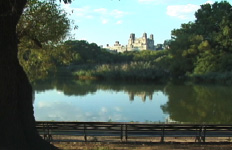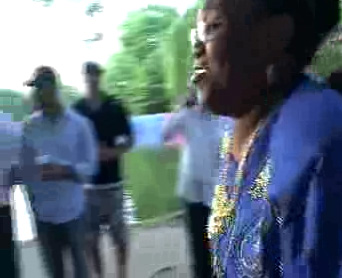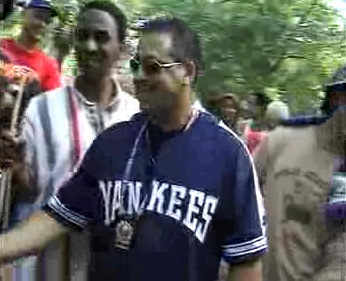Tanz und WahnSinn / Dance and ChoreoMania
audio visions
VI. Additional research materials on Tanz & WahnSinn / Dance & ChoreoMania (only on this website)
Page 1 Page 2
Berta Jottar // Conflict-O-Rumba: The Persistence of Memory (2003: 37’00). A video.


Rumba in Central Park is an internationally known music event, a trademark of Afro-Latina/o culture in New York City. After 35 years of uninterrupted Rumba performances in the Park, former Mayor Rudy Giuliani halted the events for two consecutive years under his Zero Tolerance rubric. Conflict-O-Rumba is an experimental ethnography that documents the public conflict between the Rumba community and the New York City Police between 1999 and 2001. The video replicates conceptually and formally rumba’s performance: the call-and-response relationship between musicians, dancers and singers. The video also stages a call-and-response relationship between the drummers and the police, prohibition and improvisation, history and the present. This struggle brings to light the deeper historical significance of the African drum within New York City, and how the City’s contemporary legal discourse constructs drumming as “noise” and as “disorderly conduct”. Thus, rumba in Central Park becomes the performance of an exilic condition, not only because the performers are Latinos, immigrants, or exiles; but because their performance is located outside the U.S. legal imaginary.
Above are images from the installation that the video belongs to. Central Park Rumba: The Pavlovian Drum is an extensive grass-roots, community project that introduces members of NYC rumba community through interviews about their memory of the events, the rellevance of rumba’s afrodescendant drum in their life; and rumba’s significance in NYC’s Afro-Latino/a communities
Conflict-O-Rumba
For a preview, see http://liminalities.net/5-4/rumba.html
FOR THE FULL FILME, GO HERE: Conflict-O-Rumba
For the CD release of the music from the video, listen here


Additional bibliographical references to publications by Berta Jottar
• Berta, Jottar, "Central Park Rumba: Nuyorican Identity and the Return to African Roots." Centro Journal of the Center for Puerto Rican Studies xxiii, no. 1 (2011): 4-29
• “From Central Park Rumba with Love,” Voices: The Journal of New York Folklore, 2011,pp. 24-31.
• “Rumba’s Democratic Circle in the Age of Legal Simulacra.” Performing the U.S. Latin@ Borderlands. Eds. Peter Garcia, Chela Sandoval, and Arturo Sandoval. Indiana University Press. (Forthcoming Fall, 2011)• “Zero Tolerance and Central Park Rumba Cabildo Politics.” Liminalities: A Journal of Performance Studies. (Vol.5, No.4, November 2009) <http://liminalities.net/5-4/index.html>
• “The Acoustic Body: Rumba Guarapachanguera and Abakuá Sociality in the 1990s.” Latin American Music Review/Revista de música Latinoamericana. University of Texas. (Vol. 30, Number 1, Spring/Summer, 2009): 1-24 <http://muse.jhu.edu/login?uri=/journals/latin_american_music_review/v030/30.1.jottar.pdf>
Abstract:
Since the late 1960s, summer rumbas in New York City’s Central Park have been a center for Puerto Rican music elaboration. However, since the mid-1990s, the arrival of Cuban rumberos has reshaped the practice. In this essay I analyze this transformation and suggest that Central Park rumba has the capacity to generate multiple sociopolitical, historical, and spiritual presences through sound and gesture. Centering on the interaction between the Cuban Marielitos and the balseros, I show how their encounter in Central Park rumba produces
a transnational space of cross-generational negotiation through spiritual and secular performances. I argue that while the rumba guarapachanguera became a style performed primarily by the rumberos from Cuba’s Special Period, Abakuá spiritual bonding functioned across the Mariel and balsero generations because of the deep history embodied in their performance of the Abakuá Íremes. I theorize how the performance of rumba constitutes an aural community that, once in the Diaspora, articulates what I call the “acoustic body,” a body that echoes an internalized spiritual sound via gesture.
For further research on rumba, go to ¡Vamos a Guarachar!
Bio:
Dr Berta Jottar (USA) is a videoartist-scholar from Mexico City. She is a former member of several art collectives in the Tijuana/San Diego border: Border Art Workshop/Taller de Arte Fronterizo (1988-1991) and Las Comadres (1991-1993). In New York City, Jottar received The Cynthia Jean Cohen Bull Memorial Award for Academic Excellence for her Ph.D. thesis “Rumba In Exile” at the Department of Performance Studies, NYU. Currently she is producing an experimental documentary about the history of Central Park rumba
+ + +
For radio features / radio interviews, go here
+ + +
Herausgeberin und Herausgeber / editors
Zu den Autorinnen und Autoren /authors
Bildnachweis / list of illustrations
(c) 2011 Johannes Birringer & Josephine Fenger, editors
Leipzig: Henschel Verlag, 2011. Paperback, € 19.90, ISBN-10: 3894877103
This book project is supported by
Gesellschaft für Tanzforschung (GTF)
For the publisher's announcement, click here